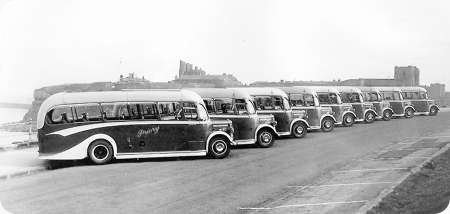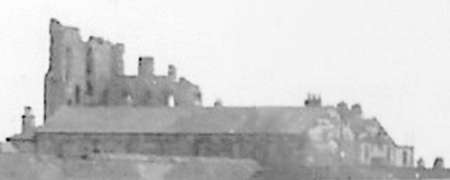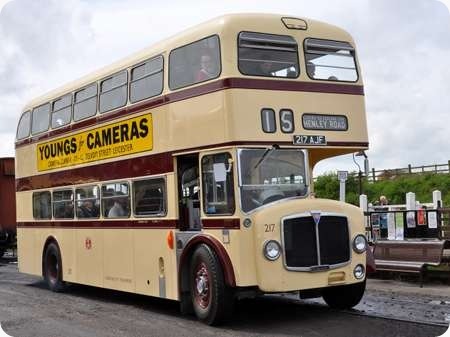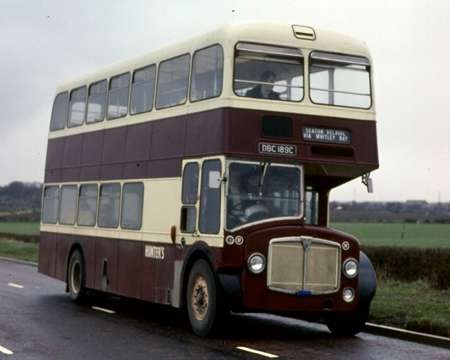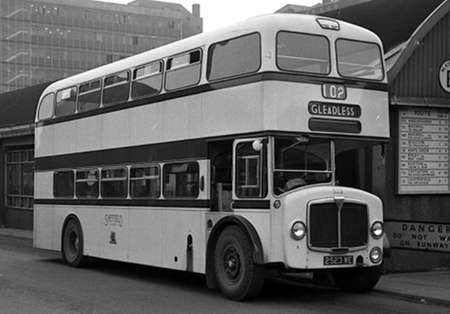Priory Coaches – Bedford OB – ?? – 47
Priory Coaches of North Shields
194?
Bedford OB
Duple C27F
My thanks to the management of Priory Coaches North Shields, for allowing me to use this photo.
An impressive line up of Duple bodied Bedford OB’s from the late 40’s (exact year unknown) In the background is Tynemouth Castle, which overlooks the mouth of the river Tyne. To the extreme left, the white building at the top of the cliffs is the Coast Guard Station.
Above the roof line of the buildings you can see the medieval monument of Tynemouth Priory, which the company is named after, at one time a gold image of the Priory was displayed on the rear of their vehicles. The livery was two shades of green and cream, with gold leaf lettering and logo, the seats were upholstered in a dark rich red moquette material. Around 1953, the layout was altered and cream became the predominant colour. On the OB‘s, the bulk of the body became cream, the roof, front and rear wings, lower skirt, radiator and bonnet tops were dark green, the wheels and the side flash below the window line was the lighter green. The present day fleet is mainly Volvo, and the livery is white with two shades of blue. The Priory logo is still used, but is no longer displayed on their vehicles, the lettering is now blue, but same shaded style font is still used.
Photograph and Copy contributed by Ronnie Hoye
12/05/14 – 08:42
Only a small number of Bedford OB coaches were produced late 1945 after the war with production increasing in 1946 a Bedford PSV circle listing would give you exact year. This listing provides date to 1st owner. Which may help you to date photograph. Sorry I do not have access to listing.
Alan Coulson
12/05/14 – 14:03
T. G. Chapman (Priory Coaches) of South Shields had the following OB/Vistas:
FT 5666: 04/46
FT 5679: 06/46
FT 5680: 06/46
FT 5884: 10/46
FT 5885: 02/47
FT 5892: 10/46
FT 5893: 01/47
FT 5894: 10/46
FT 5895: 11/47
FT 5896: 10/46
FT 6102: 11/47 (SMT body)
FT 6281: 01/48
FT 6358: 06/48
FT 6642: 05/49
FT 6795: ?
FT 6905: 1950
FT 7009: 1951
There were also 12 OB’s (6 Duple, 6 Plaxton FC30F) with FT registrations delivered between 7/46 and 12/48 to Taylor Bros. of North Shields. Some of the registration numbers of Taylor’s vehicles were in the same batches as the Priory (Chapman) ones, so I assume there was a connection between the two. This is according to the PSV Circle book on the OB.
John Stringer
13/05/14 – 06:37
John, I’m not aware of any connection between Taylor Brothers of North Shields and Priory Coaches, but that’s not to say there wasn’t one. Around 1960 ‘ish’ Taylor Bros became a subsidiary of Hall Brothers of South Shields, who subsequently became part of the Barton Group
Ronnie Hoye
13/05/14 – 13:08
Sorry Ronnie, an unfortunate typo crept into my comment above, the listed OB’s being those of G. Chapman (Priory Coaches), not Taylor Bros.
John Stringer
13/05/14 – 17:20
John, I note that one of the numbers listed is for the OB’s is FT 6905, as I said, I am not aware of any connection between Taylor Bros and Priory Coaches, however, Taylor Bros had a Daimler CVD6SD with C33F Burlingham body, registration FT 6909, only four away. The vehicle is pictured elsewhere on this site, and was last heard of tucked away in a corner of Wright Brothers depot in Nenthead, and awaiting restoration. The two depots were very close to each other, Priory was in Queen Street, and I think Taylor’s were literally just round the corner in Hudson Street. Another thing that I had quite forgotten, I don’t know when the business started, or if there was any connection between the two, but certainly from the end of the war until about the mid to late 60’s, the main Vauxhall / Bedford dealership in North Shields was also called Taylor Brothers, and they were on Tynemouth Road, which was only a stones throw from both the Priory and Taylor Bros depots. This is only speculation on my part, but the dealership changed hands at roughly the same time the coaches were taken over by Hall Brothers. death duties perhaps?
Ronnie Hoye
19/05/14 – 07:14
It was interesting to see the list of OB registrations from John Stringer, and they had me reaching for my Glass’s Index of registration numbers.
FT was the mark of the ‘County Borough Council of Tynemouth’, and was the mark allocated to it, when it became a County Borough, and commenced issuing registrations as and from 1st October 1904.
FT ran from then until January 1957.
John shows TF 5666 being registered on April 1946, and must have been only the 2nd vehicle licensed that year, because the year started at FT 5665.
Similarly in 1948 the year started at 6276, with FT 6281 being only the 6th licensed. It can be seen therefore that it was a very slow moving mark.
So it took 53 years to issue 10,000 marks, (an average of less than 200 a year), it must have been an easy job working in the Motor Vehicle Taxation Office in Tynemouth
Stephen Howarth
19/05/14 – 15:35
The DVLA seem to have stumbled upon a nice little earner in unused Tynemouth FT registrations. The BBC George Gently series is set in the early 70’s, in a recent episode I noticed an Austin with a numbers first LFT registration. Tynemouth did get as far as three letters followed by the numbers, but never with the numbers first. Incidentally, the 1 numbers, AFT 1 – BFT 1 Etc, were all Tynemouth Police vehicles.
Ronnie Hoye
20/05/14 – 16:33
The county borough of Tynemouth got as far as the start of the KFT series before it changed to AFT —B! It must have been getting a little busier in Tynemouths motor taxation office…
Tom Carr
20/05/14 – 17:20
I think we may have our wires crossed here, Tom. The first three letter FT registrations delivered to Tynemouth and District were the 1957 Willowbrook bodied Leyland PD2/12’s, they were AFT 49/53, but AFT 1 was an Austin Westminster for Tynemouth Police, and the first of every issue up to KFT were also Police vehicles. The fist issue with a suffix was in 1965 ‘C’ but the letters reverted to AFT. Under the local boundary changes of 1974, FT became a Tyne and Wear registration.
Ronnie Hoye
21/05/14 – 08:08
It wouldn’t have required a great deal of intelligence for the local villains to spot the unmarked police cars, then, Ronnie.
Roger Cox
15/06/14 – 07:57
Tom is quite right – Tynemouth got as far as KFT 333 before starting the year suffixes with AFT 1B in August 1964.
And he’s not wrong to say that it must have been getting busier in Tynemouth’s motor taxation office – by October 1974, they had reached the VFT-N series whereas Gateshead, which had made it as far as SCN 56 before adopting the year suffixes in July 1964, had only reached the RCN-N series…
Des Elmes
18/03/15 – 07:05
AFT 1 was also on a Humber Super Snipe which came chauffeur driven when I was a lad to pick Chief Constable J. J. Scott up who lived diagonally opposite my grandmothers.
Eddie Hill
Quick links to the - Comments Page - Contact Page - Home Page
